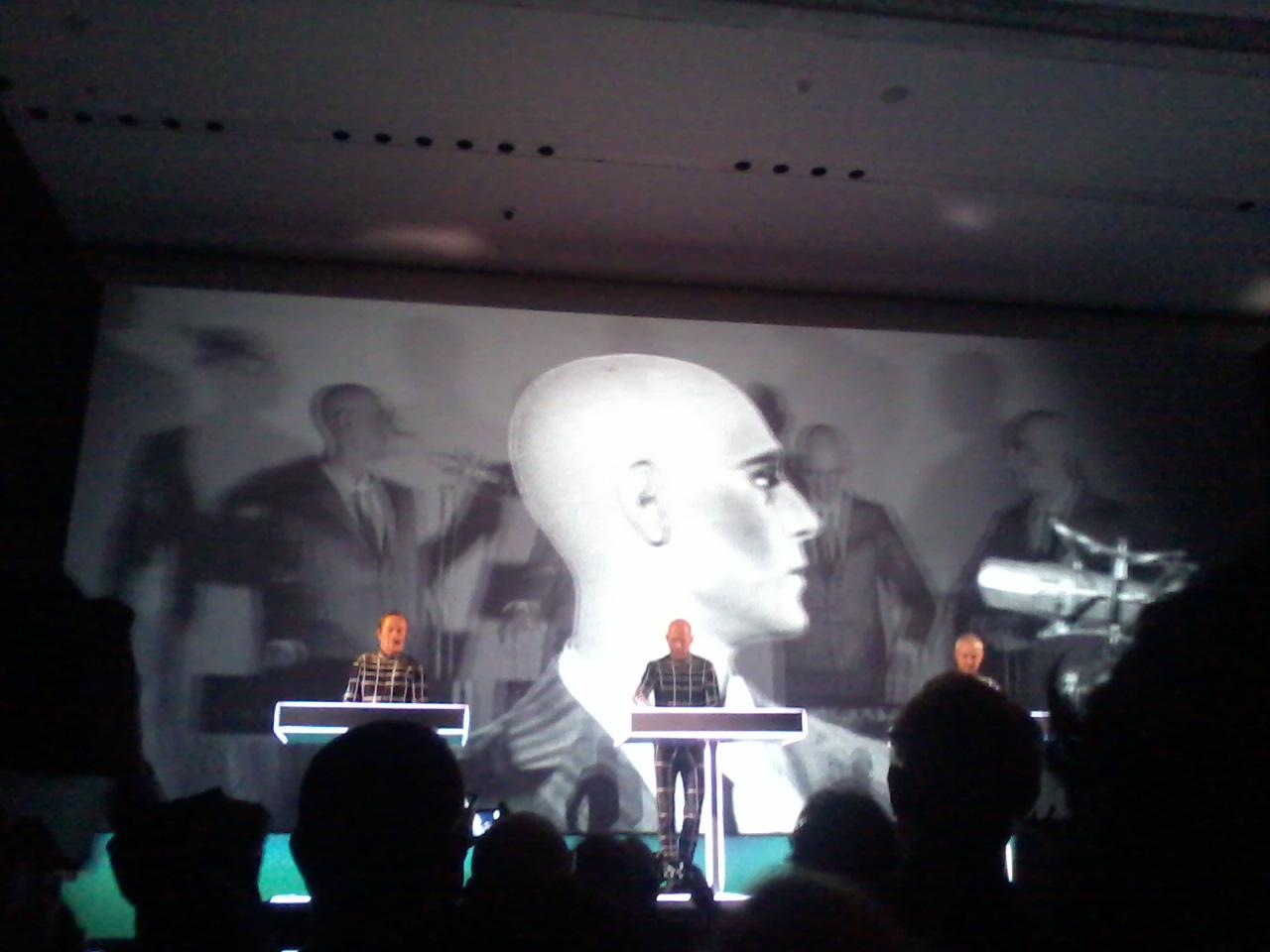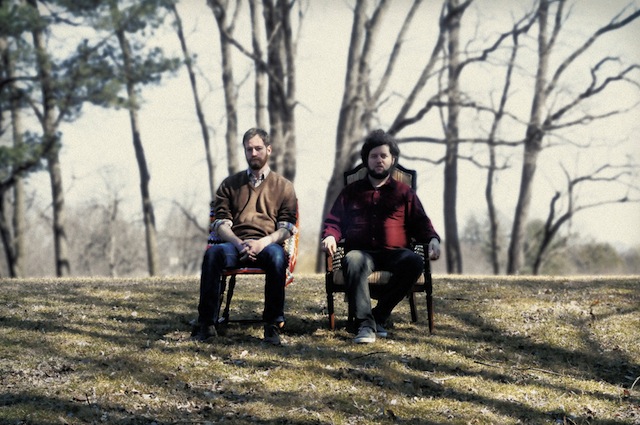Recap: Kraftwerk at MoMA

Tickets for Kraftwerk’s eight-night retrospective sold out almost as soon as they were announced. Why wouldn’t they? Eight nights, eight albums, one a night: a chronological showcase of their entire electronic period. I knew about it, but entertained no dreams of attending. I wasn’t fast enough; besides, I was broke. But a friend won a pair of tickets to last night’s show; when he offered me one, I couldn’t refuse. That would be beyond rude. It would be insane.
We arrived early at the Marron Atrium of the Museum of Modern Art, normally home to travelling exhibits. Each concertgoer received a seven-inch by seven-inch program providing a brief biography of Kraftwerk and explaining their influence. (Suffice it to say that contemporary music owes them a lot.) My companion and I also each got a pair of 3-D glasses in a sleeve specific to that night’s performance: 1977’s Trans-Europe Express. As crowds filtered in, we surveyed the merchandise table, where one could buy limited CD box sets and coffee table books on the group’s history. Around me I heard the clipped sounds of German from both event staff (the residency is sponsored by Volkswagen) and from guests. It felt … comforting. This was the right place to see them.
At precisely 8:30 PM, the lights dimmed as a series of booms emanated from the speakers. Black and white pixilated figures danced on the screen hung before the stage. I slipped the 3-D glasses over my own and shut up. Suddenly, a Vocoder-distorted voice spilt the air: a railroad station departure announcement. The curtain dropped. Kraftwerk launched into “Trans-Europe Express. The crowd erupted into cheers.
Anyone who’s heard Kraftwerk or who’s seen videos of their live performance probably would not expect them to launch into anything. “We are the robots: that’s their entire aesthetic. I expected to enjoy the concert, naturally, but I figured I would hang out in their world for a couple of hours, listen to the music, watch the projections on the screen behind the band more than the band itself. How engrossing could four men behind consoles be? But Kraftwerk were physically engaging from the start. Singer, co-founder, and sole original member Ralf Hütter wore a headset microphone, allowing him to dance behind his keyboards while he played. The other members similarly bobbed their heads and swayed behind their instruments. They didn’t make a melodramatic show of thrashing their keyboards or anything, but as I watched them I could tell they felt the music they were making. At times, the band’s subtle movements even commanded my attention away from their overwhelming visual presentation.
And visual it was. The 3-D glasses were no mere gimmick – full animations or film clips illustrated each song, to great effect. Line-drawing trains rushed at the audience during “Trans-Europe Express; shards of glass flew out during “Showroom Dummies, bringing to life lyrics about mannequins coming to life and escaping their shop windows. Much of Trans-Europe Express consists of alternate versions of the title track; therefore, Kraftwerk opted to break format and start the greatest-hits portion of the show early, starting with a near-album length rendition of their 1974 hit “Autobahn. Here the animations reached their apex: a short movie dramatizing the album’s cover painting. Over the course of twenty minutes, I watched the Volkswagen Beetle and fintail Mercedes-Benz battle each other down the highway as the music’s mood shifted from giddiness to dread, then to relief. Combined with the visual component, “Autobahn became an all-encompassing journey – unforgettable.
The rest of the setlist was well-considered and comprehensive: three songs from The Man-Machine (1978), one from Radio-Activity (1975), one from Tour de France (2001), and two each from Computer World (1981) and Techno Pop (1986). (I think – their later discography loses me somewhat.) Going in, another impression I had of Kraftwerk was that they never deviate in concert from the recorded versions of their songs. Again, I was delighted to be proven wrong. “Radio-Activity, for one, mutated from a near-ballad into a dense dance track. And while the studio version of “The Robots is a dirge, live the group syncopated the melody and removed the vocal distortion to reveal the rock song underneath; for me, it was the highest point among many, many highlights. (Close runner-up: the rarely-played “Europe Endless.)
Thematically, the central tension in Kraftwerk’s music has always been a fascination with, and simultaneous terror of, modern technology – and often, by extension, modernity itself. It’s reflected throughout their catalogue: “Autobahn’s wailing truck horns; doubts about the increasingly rapid pace of Western Europe’s unification in the Seventies underlying “Europe Endless; the list of international security agencies in “Computer World that suggests digital convenience comes at privacy’s expense. For the most part, Kraftwerk allowed their music and films to speak for themselves, celebrating the contemporary world while remaining mindful of its downsides. The exception: the aforementioned “Radio-Activity, featuring an introduction about plutonium production at Britain’s Sellafield nuclear power station and the chorus “Chernobyl, Harrisburg, Sellafield, Hiroshima added to the original lyrics.
Heavy stuff. But this potential downer did nothing to dampen the crowd’s spirits. People danced, joyfully and without ostentation – something I’ve rarely seen in a lifetime of punk and indie shows. One young woman to my left began moving three songs in and did not stop until the show had ended – an end that came only as the set approached the two hour mark. As Kraftwerk jammed out “Techno Pop over an unceasing beat, each member performed a brief synthesizer solo, bowed crisply, and exited stage left. Finally only Hütter remained. He too took his turn pounding the keys, smiling, clearly loving it. Hütter then addressed the audience for the first and only time that evening: “See you tomorrow.
The dull roar of the crowd once again exploded into a volley of cheers and clapping. It was over; people filtered from the atrium out into the darkened streets of Midtown Manhattan. I made my way to the Fifty-third Street subway station to await the E train; half the people on the platform were also clutching their programs, clearly moved by what they had just witnessed. Kraftwerk on record are an adventure in alien sounds, in technology – in a vision of the future that can be exciting, but, in large doses, also a little dull. Live, though, Kraftwerk rendered that vision human, all too wonderfully human – and so much the better for that.
Update: On Friday, April 13, Keep Albany Boring posted a review of Kraftwerk’s April 12 concert at the Museum of Modern Art that named “Techno Pop” as the final song of their set. After reading other professional reviews, we have learned that, in fact, “Musique Non-Stop” was their last song that evening. Keep Albany Boring apologizes for the error.

